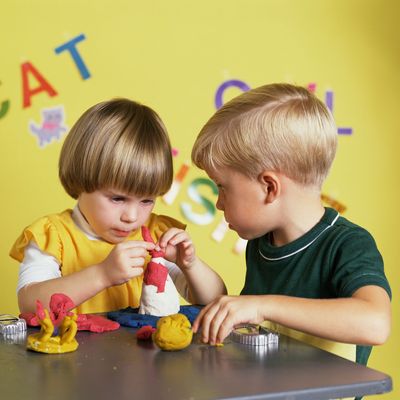
Everyone has a story, it seems, about how much more serious-minded early education is these days, especially when compared to nostalgia for the freewheeling, hand-turkey-crafting days of our own youth. (I, for one, know a 4-year-old who has already taken what seems like more than her fair share of standardized tests, considering she is 4.) Now, as NPR reports, there is some data backing these anecdotes up.
In a study published earlier this year, researchers at the University of Virginia analyzed two editions of a nationally representative annual survey — called the U.S. Department of Education’s Early Childhood Longitudinal Study — which each year collects answers from more than 2,500 kindergarten and first-grade teachers from across the country. Specifically, the researchers chose to compare teachers’ answers from 1998 with teachers’ answers from 2010. (In 1998, of course, schools hadn’t yet undergone the No Child Left Behind, test-emphasized transformation.)
The title of their resulting report kind of says it all: “Is Kindergarten the New First Grade?” Their answer, in short: Well, yeah. In their analysis, the researchers suggest that since the late 1990s, teacher expectations for kindergartners have become measurably higher, with a heavier focus on reading and math; meanwhile, time spent on things like art, math, and simple playtime has decreased. “We were surprised to see just how drastic the changes have been over a short period of time,” Daphna Bassok said in a statement. “We expected to see changes on some of these dimensions but not nearly so systematically and not nearly of this magnitude.”
Here’s a brief overview of some of the most striking changes the researchers turned up.
• Teachers in 2010 were about 33 percent more likely than teachers in 1998 to say they thought kids should start kindergarten already prepared with two of the basics: their ABCs, and how to properly handle a pencil.
• In 1998, 31 percent of teachers said that by the time a kid leaves kindergarten, she should know how to read. In 2010, that figure had increased to 80 percent.
• In 2010, about 18 percent fewer teachers reported daily music lessons, and 16 percent fewer said their students had daily art lessons, as compared to teachers in 1998.
• In 2010, classrooms were 20 percent less likely to have “discovery or play areas” as compared to classrooms in 1998.
• From 1998 to 2010, the number of teachers who said they used math and reading workbooks every day went up about 15 percent.
These changes are at least partially due to an increased emphasis on testing, but that’s not the whole story here, as NPR points out — there are some other relevant things that have changed since the 1990s, too. For one, more children are attending public preschool; also, kids are now more likely to attend full-day kindergarten instead of half-day than they were in the 1990s. “It’s possible teachers academic expectations have risen, at least in part, because more kids are coming to kindergarten better prepared,” write reporters Anya Kamenetz and Elissa Nadworny. (Also of note: This data itself is rather outdated, as it’s six years old – which means it can’t tell us what’s changed since adoption of Common Core standards.)
It’s not that higher standards for kindergartners are necessarily a negative thing; if children are ready to learn to read by kindergarten, that’s great. But the data set helps capture something many have wondered about in the abstract: Doesn’t how kids learn matter as much as what they’re learning? “The changes that seem potentially troubling are more around how kids are learning, not what kids should be learning,” Bassok told NPR. “There are classrooms that are very hands-on and allow kids to explore and also have terrific focus on math and are language-rich. Those things don’t need to be at odds at all.” If you like, by the way, you can read the full report here.




